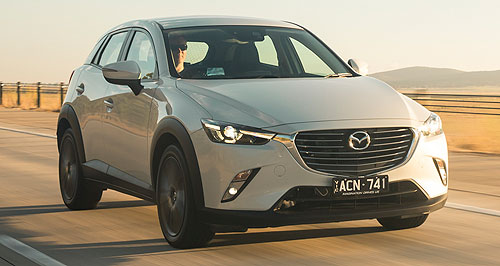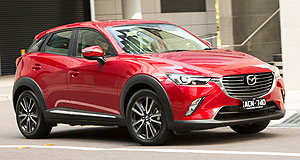Make / Model Search
News - Market Insight - Market Insight 2015Market Insight: CX-3 keeps Mazda sales firingHot ticket: Mazda’s new CX-3 is flying out of showrooms, while slowing passenger car sales tell a deeper story. The astonishing debut of CX-3 SUV shines a light on softening passenger car salesGallery Click to see larger images 11 May 2015 By TIM ROBSON THE instant success of the CX-3 crossover appears to have come at the cost of other models in Mazda’s line-up, underlining the frenetic advance of the SUV category at the expense of the passenger car set across the new-vehicle market. Australia’s leading full-line importer, Mazda is currently second behind Toyota on the list of top-selling brands in Australia, with sales up 4.5 per cent to the end of April after another all-time record result last month of more than 8000 new registrations – up 15 per cent compared with April 2014. But dive further into the figures and the performance of individual models tell a deeper story. In its first full month on sale, the diminutive CX-3 – based on the Mazda2 light-car platform – outgunned all of its rivals in the hotly contested small SUV segment to claim the win in the category for the month with 1396 sales, pipping the hitherto dominant Hyundai ix35 by seven cars. The result placed it an astonishing eleventh for overall vehicle sales in Australia, just three cars behind the Toyota RAV4 – itself an instrument in the slowdown of platform donor Corolla. Despite the fact that it only launched part-way through March, the CX-3 still managed to log 814 sales to finish fifth in class for the month, just a handful of cars behind the Mitsubishi ASX. It has made a formidable team with the nation’s biggest-selling SUV – the CX-5 – which is up 12.9 per cent year to date. The top-selling Mazda3, meanwhile, dropped 1193 units between its March and April totals this year, recording 2365 sales last month to finish second in its category behind the Corolla. With an 11.5 per cent drop on YTD numbers from 2014, sales of the Mazda3 point to a hiccup for a car that has consistently posted sales improvements month in and month out, particularly off the back of the latest model which was partially developed specifically for Australia. It also slipped back behind the Toyota HiLux to the number-three spot on the overall sales tally for April. The Mazda6 mid-size passenger car has also softened, recording a 10.3 per cent year-on-year decline, while the ageing CX-9 is currently lineball with last year and the MX-5 sportscar is treading water (managing eight units YTD compared to 39 at the same point in 2014) ahead of the new-generation model coming this year. The Mazda2 has provided positive momentum, with 5.3 per cent growth YTD, while the BT-50 has also gained slightly, with both 4x2 and 4x4 numbers up by 3.4 and 2.5 per cent respectively. Mazda Australia managing director Martin Benders told GoAuto this week that it was difficult to compare the Mazda3’s sales results to last year, given the latest-generation version was launched here early in 2014. “You’ve got to be careful when you compare Mazda3 year over year because remember the first quarter last year was when we launched the new model and we had a fair supply of the old model going through, so there was a bit of push going on there,” he said. “This year we are pretty happy. April was a little bit soft. The orders book, the tracking that we see on the contracts written, seem to be okay. We are not too concerned.” Mr Benders said that while the CX-3 is helping to draw consumers into Mazda dealerships, they may not end up purchasing the city-centric crossover. “What we are seeing is we are getting a bit of CX-3 enquiry that they (buyers) think it’s maybe a little bit on the small side for them so they are being moved into Mazda3 or CX-5,” he said. “Which is what we said at the (CX-3) launch – that this would give us opportunity to put people into the appropriate vehicle for them, based on budget and size.” Mazda Australia’s senior manager of public relations Karla Leach added that the company was delighted by the initial success of the CX-3“We are very happy with the first full month sales result for the CX-3, and know that this is a result of the strong customer interest we had in the car,” she said. “There was over 31,000 registrations of interest prior to launch, and it’s great to see this converting to sales.” She also pointed to a general softening of passenger car sales as a factor in the Mazda3’s performance. “The small passenger car segment was down 15.9 per cent in April, and the sales for Mazda3 were indicative of this trend,” she noted. “It’s an extremely competitive segment at the moment, with some aggressive pricing currently in market.” Some of that pricing pressure is coming from both Holden and Hyundai, who are seeing their respective fortunes wax and wane in the face of the Mazda onslaught. Hyundai’s i30, for example, has softened 13 per cent year on year – though a recent facelift may change its fortunes – but its ageing ix35 is still six per cent up in the same period. It will no doubt look to its upcoming Tucson SUV to bridge the gap, given that the Korean brand will not have a CX-3-esque weapon in its arsenal for several years yet. Holden, meanwhile, shows small drops in both its small passenger car line (Cruze down 11.5 per cent YTD) and small SUV line (Trax off 13.3 per cent). Its Captiva 5, however, is holding steady, gaining 1.9 per cent year on year and posting an 84 per cent increase on its numbers from April 2014. Overall, the brand has relinquished second spot to Mazda, and is down 10.1 per cent year on year. While Toyota’s Corolla sales were also down by a similar number to the Mazda3 month on month, it is clear that the new darling of the Mazda fleet – along with other strong segment performers such as the Honda HR-V – is adding to the pressure on the passenger car segment. Mr Benders told journalists at the launch of the CX-3 that while he believed the new SUV would not poach from its home fields, buyers would certainly come from sedan segments. “If the market is flat or slightly growing, and the segment has capacity for double-digit growth, where are all these buyers going to come from?” he asked. “In the same way the medium SUVs dragged in buyers from medium and large passenger cars, our research tells us that these small SUVs will draw buyers from light- and small-car segments.” The CX-3 is available in 14 variants – although the entry-level Neo will not go into production until the second quarter of this year – and can be configured with two engines – a 2.0-litre, four-cylinder petrol and Mazda’s new 1.5-litre, four-cylinder turbo diesel – across a four-strong range. A six-speed manual gearbox is available on four cars, while all-wheel drive is available on five variants. Pricing starts at $19,990 plus on-road costs, for the Neo 2WD manual, rising to $37,690 for the Akari diesel AWD model.  Read more18th of March 2015  Mazda 2015 CX-3 rangeThe Mazda CX-3 has its rivals quaking in its collective boots – and for good reason17th of March 2015  Mazda concerned about supply of new CX-3On the eve of launch, Mazda MD sounds alarm about supply of hot new CX-317th of March 2015  Driven: Mazda's CX-3 goes for the top spotExpectations are high for new Mazda CX-3, but local bosses predict a number one hit |
Click to shareMarket Insight articlesResearch Market Insight Motor industry news |












Facebook Twitter Instagram